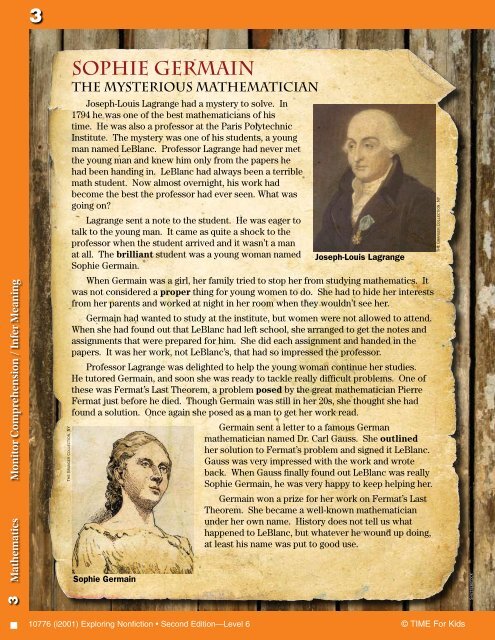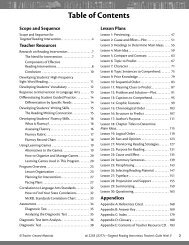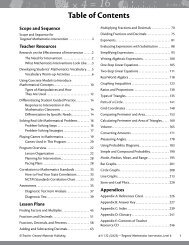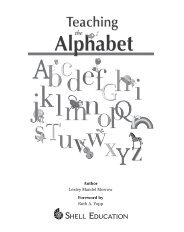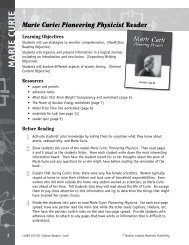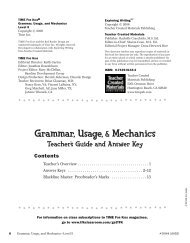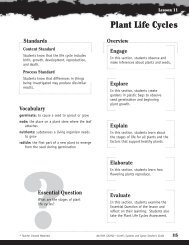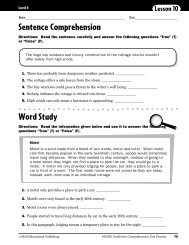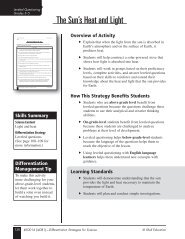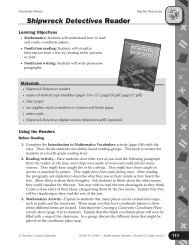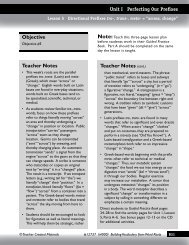3 SOPHIE GERMAIN - Teacher Created Materials
3 SOPHIE GERMAIN - Teacher Created Materials
3 SOPHIE GERMAIN - Teacher Created Materials
You also want an ePaper? Increase the reach of your titles
YUMPU automatically turns print PDFs into web optimized ePapers that Google loves.
3<br />
3 Mathematics Monitor Comprehension / Infer Meaning<br />
The Granger Collection, NY<br />
Sophie Germain<br />
The Mysterious Mathematician<br />
Joseph-Louis Lagrange had a mystery to solve. In<br />
1794 he was one of the best mathematicians of his<br />
time. He was also a professor at the Paris Polytechnic<br />
Institute. The mystery was one of his students, a young<br />
man named LeBlanc. Professor Lagrange had never met<br />
the young man and knew him only from the papers he<br />
had been handing in. LeBlanc had always been a terrible<br />
math student. Now almost overnight, his work had<br />
become the best the professor had ever seen. What was<br />
going on?<br />
Lagrange sent a note to the student. He was eager to<br />
talk to the young man. It came as quite a shock to the<br />
professor when the student arrived and it wasn’t a man<br />
at all. The brilliant student was a young woman named<br />
Sophie Germain.<br />
When Germain was a girl, her family tried to stop her from studying mathematics. It<br />
was not considered a proper thing for young women to do. She had to hide her interests<br />
from her parents and worked at night in her room when they wouldn’t see her.<br />
Germain had wanted to study at the institute, but women were not allowed to attend.<br />
When she had found out that LeBlanc had left school, she arranged to get the notes and<br />
assignments that were prepared for him. She did each assignment and handed in the<br />
papers. It was her work, not LeBlanc’s, that had so impressed the professor.<br />
Professor Lagrange was delighted to help the young woman continue her studies.<br />
He tutored Germain, and soon she was ready to tackle really difficult problems. One of<br />
these was Fermat’s Last Theorem, a problem posed by the great mathematician Pierre<br />
Fermat just before he died. Though Germain was still in her 20s, she thought she had<br />
found a solution. Once again she posed as a man to get her work read.<br />
Sophie Germain<br />
Joseph-Louis Lagrange<br />
Germain sent a letter to a famous German<br />
mathematician named Dr. Carl Gauss. She outlined<br />
her solution to Fermat’s problem and signed it LeBlanc.<br />
Gauss was very impressed with the work and wrote<br />
back. When Gauss finally found out LeBlanc was really<br />
Sophie Germain, he was very happy to keep helping her.<br />
Germain won a prize for her work on Fermat’s Last<br />
Theorem. She became a well-known mathematician<br />
under her own name. History does not tell us what<br />
happened to LeBlanc, but whatever he wound up doing,<br />
at least his name was put to good use.<br />
The Granger Collection, NY<br />
Shutterstock<br />
■<br />
10776 (i2001) Exploring Nonfiction • Second Edition—Level 6 © TIME For Kids
3<br />
Comprehension<br />
Connection<br />
Before Reading<br />
1. What is one goal you hope to reach<br />
in your life?<br />
2. Tell about a time when you solved a<br />
very difficult problem. How did you<br />
feel about it?<br />
3. For what reason might someone<br />
wish to hide his or her identity?<br />
During Reading<br />
1. Why did Sophie Germain’s family<br />
try to keep her from studying<br />
mathematics?<br />
2. Why did Germain use the identity of<br />
LeBlanc?<br />
3. For what work did Germain win a<br />
prize?<br />
Skill Focus<br />
Finding the Book that Suits You<br />
How many people read about mathematics for fun? Unless<br />
you’re a mathematician at heart, you might think few people would<br />
be interested; but you might be surprised. In fact, you may find that<br />
you like to read about math for fun when you come across stories<br />
like the one about Sophie Germain.<br />
Biographies (stories about the lives of people) are great for many<br />
reasons: you learn about very interesting people, get ideas that inspire<br />
you, get some “food for thought” about important issues, and learn<br />
about life in a different time. When you are looking for something<br />
educational to read for fun, a biography may be just the thing. If you<br />
like mathematics as a subject, then maybe the biography of a great<br />
mathematician such as Sophie Germain would really inspire you. If<br />
you dream of going into space as an astronaut, you may want to read<br />
about Neil Armstrong or another space pioneer. If you want to be a<br />
writer, read a biography about Mark Twain or Jane Austen. There are<br />
biographies to suit every interest!<br />
There are lots of other ways to pick biographies that will really<br />
interest you. Maybe you read a book for class and found that you<br />
really like the way that author writes. Look for other books by that<br />
author. Ask a classmate, teacher, or librarian for some ideas, or look<br />
at bibliographies and other resources in books and on websites. In a<br />
world full of books, you will find some that really suit you.<br />
Writing Extension<br />
After Reading<br />
1. Do you think Professor Lagrange or<br />
Dr. Gauss would have paid attention<br />
to Sophie Germain if she hadn’t<br />
proved her abilities first? Explain.<br />
2. Was it okay back then for Germain<br />
to “borrow” LeBlanc’s identity?<br />
Would it be okay now? Why?<br />
3. There are still more men than<br />
women studying mathematics and<br />
science. Why do you think that is?<br />
Should it be changed? If so, how?<br />
What would you like to be when you are an adult? Write<br />
a one-page biographical sketch about someone in that field<br />
or someone who has inspired you to think about that work.<br />
Focus on one or two events that highlight what you think is<br />
important about that person.<br />
Vocabulary<br />
1. brilliant<br />
2. proper<br />
3. posed<br />
4. outlined<br />
■<br />
10776 (i2001) Exploring Nonfiction • Second Edition—Level 6 © <strong>Teacher</strong> <strong>Created</strong> <strong>Materials</strong> Publishing
3<br />
3 Mathematics Monitor Comprehension / Infer Meaning<br />
The Granger Collection, NY<br />
Sophie Germain<br />
The Mysterious Mathematician<br />
Joseph-Louis Lagrange had a mystery to solve. In<br />
1794 he was one of the best mathematicians of his<br />
time. He was also a professor at the Paris Polytechnic<br />
Institute. The mystery was one of his students. He was<br />
a young man named LeBlanc. Professor Lagrange had<br />
never met the young man. He knew him only from the<br />
papers he had been handing in. LeBlanc had always been<br />
a terrible math student. Now his work had become the<br />
best the professor had ever seen. What was going on?<br />
Lagrange sent a note to the student. He was eager<br />
to talk to the young man. The professor was shocked<br />
when the student arrived. It was not a man at all. The<br />
brilliant student was a young woman named Sophie<br />
Germain.<br />
Joseph-Louis Lagrange<br />
When Germain was a girl, her family tried to stop her from studying mathematics. It<br />
was not a proper thing for young women to do. She had to hide her interests from her<br />
parents. She worked at night in her room when they would not see her.<br />
Germain had wanted to study at the institute. But women could not attend. She had<br />
found out that LeBlanc had left school. So she got the notes and assignments that were<br />
prepared for him. She did each assignment and turned them in. It was her work, not<br />
LeBlanc’s, that had impressed the professor.<br />
Professor Lagrange was delighted to help the young woman continue her studies. He<br />
tutored Germain. Soon she was ready to do some difficult problems. One of these was<br />
Fermat’s Last Theorem. This was a problem posed by the great mathematician Pierre<br />
Fermat just before he died. Though Germain was still in her 20s, she thought she had<br />
found a solution. Once again she posed as a man to get her work read.<br />
Sophie Germain<br />
Germain sent a letter to a famous German<br />
mathematician. His name was Dr. Carl Gauss. She<br />
outlined her solution to Fermat’s problem and signed it<br />
LeBlanc. Gauss was impressed with the work and wrote<br />
back. He later found out LeBlanc was really Sophie<br />
Germain. But he was happy to keep helping her.<br />
Germain won a prize for her work on Fermat’s Last<br />
Theorem. She became a well-known mathematician<br />
under her own name. No one knows what happened to<br />
Mr. LeBlanc. Whatever he wound up doing, at least his<br />
name was put to good use.<br />
The Granger Collection, NY<br />
Shutterstock<br />
●<br />
10776 (i2001) Exploring Nonfiction • Second Edition—Level 6 © TIME For Kids
3<br />
Comprehension<br />
Connection<br />
Before Reading<br />
1. What is one goal you have?<br />
2. Tell about a time when you solved<br />
a hard problem. How did you feel<br />
about it?<br />
3. Why would someone want to hide<br />
his or her identity?<br />
During Reading<br />
1. Why did Sophie Germain’s family<br />
try to keep her from studying math?<br />
2. Why did Germain use LeBlanc’s<br />
name?<br />
3. What did Germain do to win a<br />
prize?<br />
Skill Focus<br />
Finding the Book that Suits You<br />
How many people read about math for fun? Unless you’re a<br />
mathematician at heart, you might think the answer is no one. But<br />
you might be surprised. In fact, you may find that you like to read<br />
about math for fun when you see stories like the one about Sophie<br />
Germain.<br />
Biographies are stories about the lives of people. They are<br />
great for a lot of reasons. You learn about very interesting people.<br />
You can get ideas that make you think about big issues. You can<br />
even learn about life in a different time. When you are looking for<br />
something to read for fun and for learning, a biography may be just<br />
the thing. Do you like math as a subject? Then maybe the biography<br />
of a great mathematician such as Sophie Germain would really<br />
inspire you. Do you dream of going into space as an astronaut?<br />
Read about Neil Armstrong or another space pioneer. Do you want<br />
to be a writer? Read a biography about Mark Twain or Jane Austen.<br />
There are biographies to interest everyone!<br />
There are other ways to pick biographies that you might like.<br />
Maybe you read a book for class. Maybe you find that you really<br />
like the way that author wrote. Look for other books by that author.<br />
Ask a classmate, teacher, or librarian for some ideas. Look at<br />
bibliographies and other resources in books and on websites. In a<br />
world full of books, you will find some that really suit you.<br />
Writing Extension<br />
After Reading<br />
1. Do you think Professor Lagrange<br />
or Dr. Gauss would have noticed<br />
Sophie Germain if she hadn’t proved<br />
herself first? Explain.<br />
2. Was it okay back then for Germain<br />
to “borrow” LeBlanc’s identity?<br />
Would it be okay now? Why?<br />
3. There are still more men than<br />
women studying math and science.<br />
Why do you think that is? How<br />
could this be changed?<br />
What would you like to be when you are an adult? Think<br />
about someone in that field. Or, think of someone who has<br />
made you think about that work. Write about that person.<br />
Focus on one or two events that show what you think is<br />
important about that person.<br />
Vocabulary<br />
1. brilliant<br />
2. proper<br />
3. posed<br />
4. outlined<br />
●<br />
10776 (i2001) Exploring Nonfiction • Second Edition—Level 6 © <strong>Teacher</strong> <strong>Created</strong> <strong>Materials</strong> Publishing


